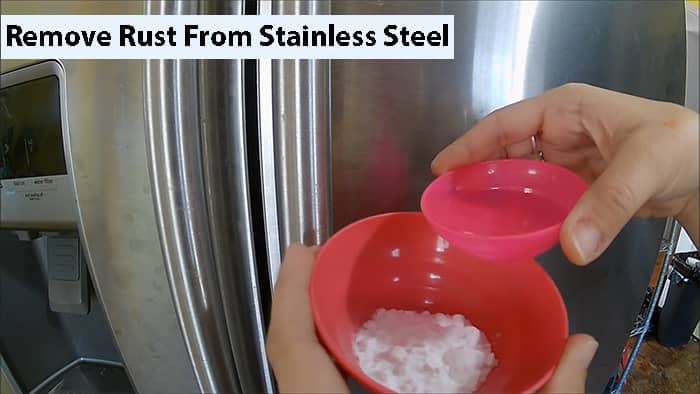Most of our household or rather kitchen essentials are made up of steel. Most utensils, tabletop surfaces, and appliances in our kitchen are made of steel. Steel is resistant to rust and tarnishing, which makes it the most suitable material for making kitchen essentials.
However, due to continued smearing and touching, the chromium plating may get depleted. And once the plating is removed, the steel starts to rust.
If you are looking for ways to remove rust from your steel appliances or utensils, you have come to the right place! In a short period, we will get you covered in a few paragraphs on how to remove those rusty stains from your utensils and make them new like before.

So, without further delay, let us get started on how to remove rust from stainless steel!
Contents
Does/Can Stainless Steel Rust?
Although stainless steel has built-in corrosion resistance, it can and will rust under certain conditions—albeit not as rapidly or as severely as conventional steel. When stainless steel is exposed to harmful chemicals, salt, grease, moisture, or heat over an extended period.
And in the kitchen, such conditions are often present, so the chances of stainless steel kitchen appliances or utensils getting rusted are quite higher.
The quantity of chromium present in stainless steel determines how well it resists corrosion. When the top layer of stainless steel is scratched off, a new chromium oxide layer cannot form because there is not enough chromium at the surface.
Most of the time, extreme fingerprints and smearing may diminish the chromium layer. As a result, the material is highly susceptible to corrosion. So, if your question is, “Can stainless steel rust?”, then the answer is yes, it can rust.
So, let us get started with the methods to remove rust from stainless steel!
How To Get Rust Off Stainless Steel Using Cream Of Tartar?
- To begin, add a full tablespoon of cream of tartar with several drops of lemon juice. A dry, powdery, acidic residue of winemaking, cream of tartar is used in a variety of baking recipes, from cookies to cakes to frosting. Hence, it is easy to find it at grocery shops. Cream of Tartar is a common name for potassium hydrogen tartrate.
- Mixing the cream of tartar and lemon juice will create a thick paste. Now you may use the thick paste to remove all those ugly rusty stains from your beautiful stainless steel equipment.
- In the next step, you will require a soft sponge, which you will use to apply the thick paste to all the rust stains on the surface of your stainless steel equipment.
- Now that you have applied the paste to rusty spots, oxidation will take place shortly. After a while, use a moist cloth to remove the paste from the spots and then dry them with a piece of cloth. All your rust marks have been removed, and the equipment is now as new as before!
This is a very easy and fast remedial solution to remove the rusty stains from your stainless steel utensils and applications. However, this method is effective for treating small rust stains only.
Removing Rust From Stainless Steel Using Baking Soda Paste
- For this method of removing rust stains, you will require a few common things from your kitchen, like baking powder, water, an old toothbrush, and a piece of cloth. Baking powder is the most commonly found ingredient in the kitchen. It is similar to baking soda (sodium bicarbonate) except it also contains a weak acid.
- Firstly, prepare a thick paste using ¼ cup of baking soda and water respectively. You will use this paste to remove stains from your steel utensils.
- Before applying the paste, wash the stain with mild soap and water.
- With the help of an old toothbrush, apply the paste gently to the rust stains and scrub them. You may repeat this step many times until the rusty spots are finally gone.
- Once all the stops are removed, rinse the paste with water and dry it with the help of a dry cloth. Within a matter of time, all your rust stains are gone from your stainless steel equipment.
Baking soda is ideal for cleaning coins, clothes, and tile grout due to its moderate abrasiveness and cleaning powers. It’s the best option for keeping stainless steel looking clean, whether it’s on your stainless appliances or flatware. It can even be used to eliminate rust from gardening tools or items used when working on an automobile.
How To Clean Rust Off Stainless Steel With Lemon Juice?
- To make a paste, combine equal parts lemon juice and baking soda. For example, one tablespoon of lemon juice and one tablespoon of baking soda could be combined. Lemon juice contains citric acid which reacts with the iron oxide or the rust and facilitates its removal.
- Now take the thick paste and apply it to the rust-affected area. Let it sit for 15-20 minutes.
- After 20 minutes or so have passed, then use a damped scrub it away with a damp sponge.
- If the rust persists after one application, leave the paste on for 15-30 minutes before scrubbing it away with a damp sponge.
- Lime juice can be used as a substitute for lemon juice.
This method is quite feasible for appliances and utensils having small rust spots. Citric acid levels in limes and lemons range from 8% to 10%, whereas grapefruits, mandarines, and oranges have lower levels. This is the secret element for removing rust stains.
Use Vinegar To Remove Rust From Stainless Steel Appliances
- This method of rust removal will require you to have at least two cups of white vinegar, an old toothbrush, a bowl or cup, and a cleaning cloth. Vinegar may be the only household item with more cleaning applications than baking soda. Vinegar includes acetic acid, a mild acidic cleanser that breaks down metal and grime.
- Fill the container with vinegar and, if feasible, submerge the stainless steel item. If the object is too big to submerge in vinegar, pour the vinegar directly on the rust. Allow five minutes for the vinegar to act on the rust.
- Scrub any remaining rust stains with the toothbrush bristles until they are entirely gone.
- Next, we should wipe the area dry with a clean, dry towel after rinsing it with water.
- Did you know that you can simply clean a stainless steel coffee pot with vinegar, both inside and out? Vinegar not only removes coffee stains and odors but also sanitizes the coffee machine.
Vinegar can be used to clean a vent hood that has become soiled with grease marks, as well as a variety of other surfaces around the house. Vinegar effortlessly cuts through grease and restores the brilliance of stainless steel.
FAQ’s:
stain-free. It has a thin layer of chromium coating that prevents the steel from corrosion. However, if the layer is removed by any means, rusting may take place.
The rust stains can be removed by using household products like lemon, baking powder, vinegar, and cream of tartar.
For small stains using a mixture of baking powder and lemon juice is very effective in removing rust stains. Moreover, they are easily available inside your house.
Yes, vinegar and baking soda can be used to remove rust stains from stainless steel appliances and utensils.
Conclusion:
The easiest technique to maintain stainless steel surfaces rust-free is to avoid all the sources that can actually cause corrosion. Regular care may also maintain these surfaces in good repair, so knowing how to clean stainless steel is beneficial.
Start with common household items like baking soda, vinegar, and a soft cloth when rust forms. Alternatively, prepare your elbow with stainless steel cleaning and rust remover (with oxalic acid for optimal results).
When the rust has been removed, thoroughly rinse and dry the surface. If some rust remains, you may need to repeat the operation. Use the proper cleaners, towels, and scrubbers when removing rust from stainless steel.
Stainless steel can be damaged by some chemicals and rough objects (such as steel wool). The first step is to look out how to remove rust from stainless steel equipment on the manufacturer’s website.
Hi, This is Ayush Badhoni a passionate blogger from India, loves in researching and writing on various topics like home appliances, gadgets, beauty e.t.c I love to review products and give the best to my readers.
